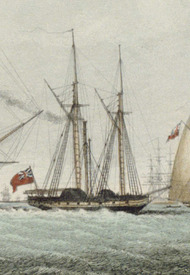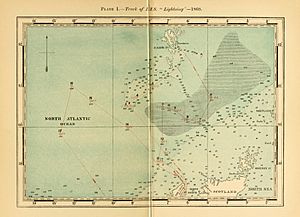HMS Lightning (1823) facts for kids
HMS Lightning was a special ship launched in 1823. It was one of the very first ships in the British Navy to be powered by a steam engine, using large paddles to move through the water. At first, it carried mail and passengers, like a delivery service. But later, it became a science ship, exploring the ocean.
Contents
Early Missions
In 1835, Lightning was busy mapping the Irish Sea. This was important work to create better sea charts. The next year, in 1836, the ship helped with some interesting tests. Scientists wanted to see how fast Lightning could go and how much coal it used at different steam levels. They found that using less steam made the ship slower, but it saved a lot of fuel. This meant the ship could travel much farther without needing to refuel.
War Service
From 1854 to 1855, during a big conflict called the Crimean War, Lightning played an important role. It was sent to the Baltic Sea to scout and map the area. The narrow waterways around the Åland Islands had never been properly mapped before. Lightning did this vital job. Then, it guided other ships carrying soldiers to a landing spot. This helped the soldiers successfully attack a fortress called Bomarsund in August 1854.
Exploring the Deep Sea
The Start of Ocean Science
In 1865, Lightning went back to mapping the west coast of Great Britain. But soon, it got a new and exciting job! In 1868, two famous scientists, Charles Wyville Thomson and William Benjamin Carpenter, used Lightning for a special trip. They wanted to explore the deep parts of the Atlantic Ocean. This was one of the first big science trips to study the ocean floor.
The scientists had an important question to answer. Another scientist named Edward Forbes had suggested that there was no life in the ocean below a certain depth. He called this the "azoic zone," meaning "no life zone." The Royal Society, a group of important scientists, helped Thomson and Carpenter get Lightning from the Navy to test this idea.
Discoveries of the 1868 Voyage
The voyage of Lightning in August and September 1868 was not easy. The ship was old, and the weather was bad. But even with these challenges, the scientists made amazing discoveries!
They used special equipment to scoop up samples from the deepest parts of the ocean, even from 650 fathoms (1,190 m) (about 1,189 meters or 3,900 feet) down. They found clear proof that there was animal life in these super deep places! This showed that Edward Forbes' idea of an "azoic zone" was wrong.
They also measured the water temperature. Before this, many people thought the deep ocean was always the same temperature. But Lightning's measurements showed that some deep areas were colder and some were warmer. This suggested that there were powerful currents moving water around in the deep ocean. The scientists also found many new types of sea creatures that no one had ever seen before.
These amazing findings made scientists and the Navy want to support even more deep-sea exploration. Later, other ships like HMS Porcupine continued this important work.
Final Years
After its scientific adventures, Lightning went back to mapping the west coast of Great Britain. The ship was finally taken apart in 1872, after many years of service as both a naval vessel and a pioneering science ship.




